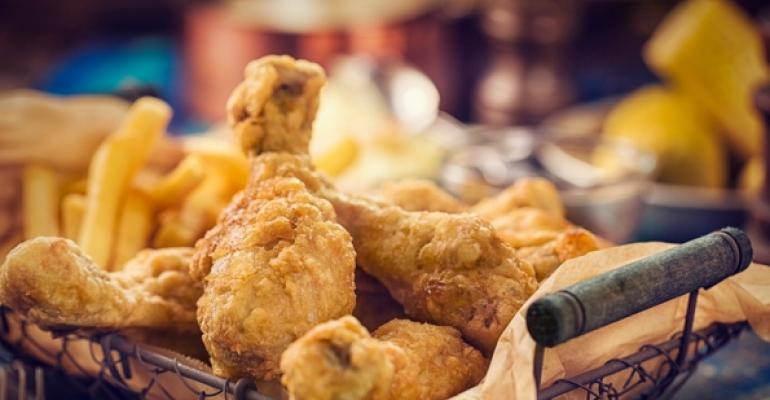Dry or with humidity?
That’s a key question to ask when specifying your next heated holding cabinet. It's especially germane if your menu includes challenging items such as bone-in fried chicken (crispy breading, moist interior), pizza (crispy crust, melty top) or starchy foods such as pasta or rice (easy to dry out).
Extended hold times enable you to prepare food during off-peak hours, so you can serve delicious, hot items on demand during crunch times. Adding humidity has “more than doubled hot holding times for such foods as bone-in fried chicken, rice, ribs, rolls, pizza and pork chops,” says Dann Woellert, product manager for Henny Penny. The versatile cabinets also can be used to proof and hold in the same cabinet, or finish slow-cooked ribs overnight.
“The idea of hot holding is to keep moisture within the food in order to maintain its just cooked quality for longer times,” Woellert says. “The goal is to create an equilibrium between moisture coming off the product and humidity being generated within the box.”
Humidified holding cabinets can help speed cook times, too. At Fatburger/Buffalo’s Express co-branded restaurants, humidified heated holding cabinets with a cook function allow kitchen staffers to safely hold par-cooked chicken wings at 135° Fahrenheit for the length of a whole shift, about four hours.
“That way we can put wings into the fryer and have them ready to serve in five minutes — the same cook time as our burgers — instead of the 15 minutes that would be required if cooking from frozen,” says James Newell, vice president of operations for the 178-unit Beverly Hills, Calif.-based Fatburger chain. “We rely on the humidity in the cabinets to maintain the quality. The units we tested without the humidity resulted in too dry a product.”
Controlling Humidity
Boosting humidity in heated holding cabinets can be as simple as placing a pan of water inside the cabinet. But to truly keep product at its original degree of moistness, units that allow control of the humidity levels might be a better bet. Monitors built into such units regulate the amount of water vapor while vents allow the escape of excess moisture to maintain equilibrium.
Humidified heating cabinets are usually constructed with a greater amount of insulation than the simple dry boxes, which will save money on utility costs over the life of the unit.
Some units, such as Henny Penny’s SmartHold® humidified holding cabinet, allow operators to control moisture levels in 1 percent increments from 10 percent to 90 percent relative humidity. These cabinets rely on a smart control system that adjusts temperature, humidity levels, fan and vent as needed. Other features that can improve food safety and operations include food probes to monitor temperatures, self-diagnostics and programmable countdown timers, to name a few.
You’ll need to choose between manual fill and auto-filling the water reservoir, which holds two to three gallons depending on model and size. If you need a hot holding box capable of moving from kitchen to serving point and back, you’ll need a manual fill unit. A low water warning light alerts operators when water must be replenished. For units that will stay in one place, a direct plumbing option automatically fills and tops off the reservoir, and a floor drain permits easy emptying at the end of a shift.
And you’ll need to choose how large your box will be — full size or half. If yours is a high volume operation with multiple menu items, a pair of stacked half-size cabinets gives the same capacity as a full size unit, but with two separate holding environments and control sets.
Finessing Hot Holding
How exactly will you be holding your product? “If your protein is tightly covered, the moisture it emits will stay in the pan and you’ve defeated the purpose of having a humidified cabinet,” says Mark Finck, senior engineer at the Pacific Gas & Electric Food Service Technology Center, a restaurant equipment testing facility in San Ramon, Calif. “The goal in holding proteins is for the moisture in the cavity and in the product to match so you’re neither losing nor gaining moisture. Hot holding is part science, part art.”
High volume operations in which the cabinet door is opened frequently “may need experimentation with humidity levels, setting them slightly higher to compensate for escaped moisture,” Finck says.
Manufacturers always will offer hot holding guidelines for various foods. “Check out your maker’s recommended settings for various products,” Finck says. “For example, fried items need to be kept warm with vents open to release excess moisture to keep the surface crisp.
Food scientists at Henny Penny have noted that proteins give off different amounts of moisture over time. “Our testers have developed two-stage holding ‘recipes’ with one setting for the first hour, and an adjusted one for the second hour,” Woellert says.
Selecting a heated cabinet that is suitable for your restaurant operation depends on a number of elements, such as menu type, production levels and capabilities. But when making an investment decision such as this, it is always wise to consult an expert for recommendations based on your operation’s unique situation.

